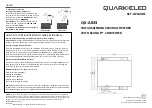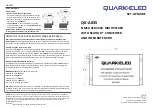
CIO-EXP16 User's Guide
Installing the CIO-EXP16
Channel selection for the DAS08 family
The DAS08 family of boards has eight channels of input, so only CIO-EXP16 jumper positions 0-7 are valid.
Many boards in the DAS08 family of boards have single-ended inputs, which is the correct type to connect to a
CIO-EXP16. If the inputs on the board type you are using are differential, they must be converted to single-
ended inputs (refer to the hardware user's manual supplied with your A/D board for more information).
You can connect up to eight banks of 16 CIO-EXP16 inputs to a DAS08 series board, for a total of 128 inputs.
Channel selection for the DAS16 family
The CIO-EXP16 jumper positions 0-7 and 8-15 can be used with the CIO-DAS16. You can connect up to 16
banks of 16 CIO-EXP16 inputs to a DAS16 series board, for a total of 256 inputs.
Most of the DAS16 family of A/D is switch-selectable for either 8 differential or 16 single-ended channels. Set
the switch for 16-channel, single-ended mode.
EXP Gain
The CIO-EXP16 has a bank of four DIP switches that control the gain of the differential amplifier (
Figure 8. Gain switch
4
3
2
1
x500
x200
x100
x10
S1
ON = left
The gain associated with a switch is 'ON' when the switch is to the left, and 'OFF' when the switch is to the
right. The gains are additive, so a total of 16 different gains are possible. The board is shipped with all switches
off (gain =1). The switch shown in Figu
is configured for a gain of 700 (500 + 200).
For most thermocouple applications, the gain should be set to at least 100. Refer to the section
on page 20 for data on setting optimum amplifier gains when using thermocouples.
For most other applications, the gain should be set to result in output signal levels as close to ±5V or ±10V
(depending on the range setting on the A/D board) as possible.
Solder gap switches
Each analog input channel on the CIO-EXP16 has three dedicated solder gap switches labeled
C
,
V
, and
G
on
the circuit side (under side) of the board. Each solder gap switch enables a different thermocouple option. A
typical set of solder gap switches is shown here.
V C G
Figure 9. Solder gap switches (typical per channel)
A solder gap switch has two pads. Turn on each switch by soldering the pads together to close them — this is
called a
solder bridge
. When closed, or bridged, the pads connect resistors and capacitors to the input signals
and enable the following options:
Open thermocouple detect
(V pad) — enables open thermocouple detection to alert you if a
thermocouple breaks. Note that your software program must be designed to recognize when a negative
full-scale condition exists, since the input is pulled to minus full-scale if the thermocouple wire is
broken or disconnected.
Input filter
(C pad) — connects a 1
µ
F capacitor across the signal high and low inputs. This forms a
7 Hz low pass filter that filters out signal noise that is picked up on the thermocouple wire.
16
Summary of Contents for CIO-EXP16
Page 1: ......












































